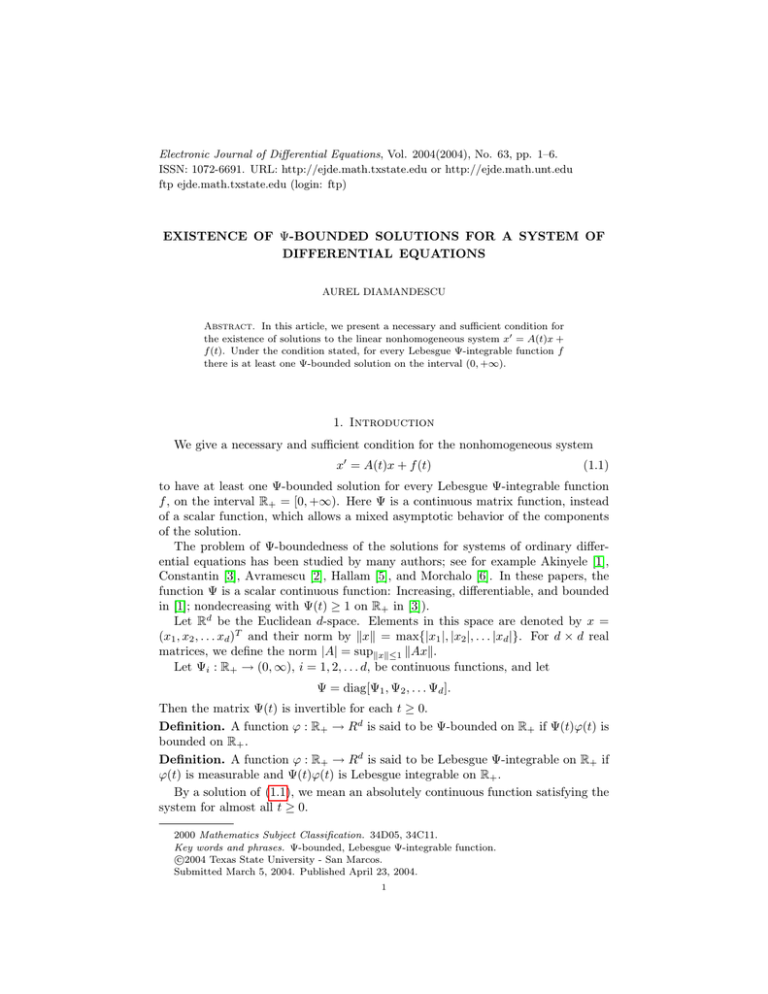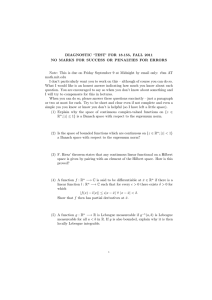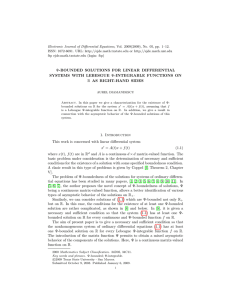Electronic Journal of Differential Equations, Vol. 2004(2004), No. 63, pp.... ISSN: 1072-6691. URL: or
advertisement

Electronic Journal of Differential Equations, Vol. 2004(2004), No. 63, pp. 1–6.
ISSN: 1072-6691. URL: http://ejde.math.txstate.edu or http://ejde.math.unt.edu
ftp ejde.math.txstate.edu (login: ftp)
EXISTENCE OF Ψ-BOUNDED SOLUTIONS FOR A SYSTEM OF
DIFFERENTIAL EQUATIONS
AUREL DIAMANDESCU
Abstract. In this article, we present a necessary and sufficient condition for
the existence of solutions to the linear nonhomogeneous system x0 = A(t)x +
f (t). Under the condition stated, for every Lebesgue Ψ-integrable function f
there is at least one Ψ-bounded solution on the interval (0, +∞).
1. Introduction
We give a necessary and sufficient condition for the nonhomogeneous system
x0 = A(t)x + f (t)
(1.1)
to have at least one Ψ-bounded solution for every Lebesgue Ψ-integrable function
f , on the interval R+ = [0, +∞). Here Ψ is a continuous matrix function, instead
of a scalar function, which allows a mixed asymptotic behavior of the components
of the solution.
The problem of Ψ-boundedness of the solutions for systems of ordinary differential equations has been studied by many authors; see for example Akinyele [1],
Constantin [3], Avramescu [2], Hallam [5], and Morchalo [6]. In these papers, the
function Ψ is a scalar continuous function: Increasing, differentiable, and bounded
in [1]; nondecreasing with Ψ(t) ≥ 1 on R+ in [3]).
Let Rd be the Euclidean d-space. Elements in this space are denoted by x =
(x1 , x2 , . . . xd )T and their norm by kxk = max{|x1 |, |x2 |, . . . |xd |}. For d × d real
matrices, we define the norm |A| = supkxk≤1 kAxk.
Let Ψi : R+ → (0, ∞), i = 1, 2, . . . d, be continuous functions, and let
Ψ = diag[Ψ1 , Ψ2 , . . . Ψd ].
Then the matrix Ψ(t) is invertible for each t ≥ 0.
Definition. A function ϕ : R+ → Rd is said to be Ψ-bounded on R+ if Ψ(t)ϕ(t) is
bounded on R+ .
Definition. A function ϕ : R+ → Rd is said to be Lebesgue Ψ-integrable on R+ if
ϕ(t) is measurable and Ψ(t)ϕ(t) is Lebesgue integrable on R+ .
By a solution of (1.1), we mean an absolutely continuous function satisfying the
system for almost all t ≥ 0.
2000 Mathematics Subject Classification. 34D05, 34C11.
Key words and phrases. Ψ-bounded, Lebesgue Ψ-integrable function.
c
2004
Texas State University - San Marcos.
Submitted March 5, 2004. Published April 23, 2004.
1
2
A. DIAMANDESCU
EJDE-2004/63
Let A be a continuous d × d real matrix and the associated linear differential
system be
y 0 = A(t)y.
(1.2)
Also let Y be the fundamental matrix of (1.2) with Y (0) = Id , the identity d × d
matrix.
Let X1 denote the subspace of Rd consisting of all vectors which are values of
Ψ-bounded solutions of (1.2) at t = 0. Let X2 be an arbitrary closed subspace of
Rd , supplementary to X1 . Let P1 , P2 denote the corresponding projections of Rd
onto X1 , X2 .
2. The Main Results
In this section, we give the main results of this Note.
Theorem 2.1. If A is a continuous d × d real matrix, then (1.1) has at least one
Ψ-bounded solution on R+ for every Lebesgue Ψ-integrable function f on R+ if and
only if there is a positive constant K such that
|Ψ(t)Y (t)P1 Y −1 (s)Ψ−1 (s)| ≤ K,
|Ψ(t)Y (t)P2 Y
−1
−1
(s)Ψ
(s)| ≤ K,
for 0 ≤ s ≤ t,
for 0 ≤ t ≤ s.
(2.1)
Proof. First, we prove the “only if” part. We define the sets:
CΨ = {x : R+ → Rd : x is Ψ-bounded and continuous on R+ },
B = {x : R+ → Rd : x is Lebesgue Ψ-integrable on R+ },
D = {x : R+ → Rd : x is absolutely continuous on all intervals J ⊂ R+ , Ψ-bounded
on R+ , x(0) in X2 , x0 (t) − A(t)x(t) in B}.
It is well-known that CΨ is a real Banach space with the norm
kxkCΨ = sup kΨ(t)x(t)k.
t≥0
Also, it is well-known that B is a real Banach space with the norm
Z ∞
kxkB =
kΨ(t)x(t)kdt.
0
The set D is obviously a real linear space and
kxkD = supkΨ(t)x(t)k + kx0 − A(t)xkB
t≥0
is a norm on D.
Now, we show that (D, k · kD ) is a Banach space. Let (xn )n be a fundamental
sequence in D. Then, (xn )n is a fundamental sequence in CΨ . Therefore, there
exists a continuous and bounded function x : R+ → Rd such that
lim Ψ(t)xn (t) = x(t),
n→∞
uniformly on R+ .
Denote x̄(t) = Ψ−1 (t)x(t) ∈ CΨ . From
kxn (t) − x̄(t)k ≤ |Ψ−1 (t)|kΨ(t)xn (t) − x(t)k,
it follows that limn→∞ xn (t) = x̄(t), uniformly on every compact of R+ . Thus,
x̄(0) ∈ X2 .
EJDE-2004/63
EXISTENCE OF ψ-BOUNDED SOLUTIONS
3
On the other hand, (fn (t)), where fn (t) = Ψ(t)(x0n (t) − A(t)xn (t)), is a fundamental sequence in L, the Banach space of all vector functions which are Lebesgue
integrable on R+ with the norm
Z ∞
kf k =
kΨ(t)f (t)kdt.
0
Thus, there is a function f in L such that
Z ∞
lim
kfn (t) − f (t)kdt = 0.
n→∞
0
Putting f¯(t) = Ψ−1 (t)f (t), it follows that f¯(t) ∈ B
For a fixed, but arbitrary, t ≥ 0, we have
x̄(t) − x̄(0) = lim (xn (t) − xn (0))
n→∞
Z t
= lim
x0n (s)ds
n→∞ 0
Z t
[(x0n (s) − A(s)xn (s)) + A(s)xn (s)]ds
= lim
n→∞ 0
Z t
{Ψ−1 (s)[fn (s) − f (s)] + f¯(s) + A(s)xn (s)}ds
= lim
n→∞ 0
Z t
=
[f¯(s) + A(s)x̄(s)]ds.
0
It follows that x̄ (t) − A(t)x̄(t) = f¯(t) ∈ B and x̄(t) is absolutely continuous on all
intervals J ⊂ R+ . Thus, x̄(t) ∈ D. From limn→∞ Ψ(t)xn (t) = Ψ(t)x̄(t), uniformly
on R+ and
Z ∞
kΨ(t)[(x0n (t) − A(t)xn (t)) − (x̄0 (t) − A(t)x̄(t))]kdt = 0,
lim
0
n→∞
0
it follows that limn→∞ kxn − x̄kD = 0. Thus, (D, k · kD ) is a Banach space.
Now, we define
T : D → B, T x = x0 − A(t)x.
Clearly, T is linear and bounded, with kT k ≤ 1. Let T x = 0. Then, x0 = A(t)x, x ∈
D. This shows that x is a Ψ-bounded solution of (1.2). Then, x(0) ∈ X1 ∩X2 = {0}.
Thus, x = 0, such that the operator T is one-to-one.
Now, let f ∈ B and let x(t) be the Ψ-bounded solution of the system (1.1). Let
z(t) be the solution of the Cauchy problem
z 0 = A(t)z + f (t),
z(0) = P2 x(0).
Then, x(t)−z(t) is a solution of (1.2) with P2 (x(0)−z(0)) = 0, i.e. x(0)−z(0) ∈ X1 .
It follows that x(t) − z(t) is Ψ-bounded on R+ . Thus, z(t) is Ψ-bounded on R+ . It
follows that z(t) ∈ D and T z = f . Consequently, the operator T is onto.
From a fundamental result of Banach: “If T is a bounded one-to-one linear
operator from Banach space onto another, then the inverse operator T −1 is also
bounded, we have that there is a positive constant K = kT −1 k − 1 such that, for
f ∈ B and for the solution x ∈ D of (1.1),
Z ∞
sup kΨ(t)x(t)k ≤ K
kΨ(t)f (t)k.
t≥0
0
4
A. DIAMANDESCU
EJDE-2004/63
For s ≥ 0, δ > 0, ξ ∈ Rd , we consider the function f : R+ → Rd ,
(
Ψ−1 (t)ξ, for s ≤ t ≤ s + δ
f (t) =
0,
elsewhere.
Then, f ∈ B and kf kB = δkξk. The corresponding solution x ∈ D is
Z s+δ
x(t) =
G(t, u)du,
s
where
(
Y (t)P1 Y −1 (u),
for 0 ≤ u ≤ t
G(t, u) =
−Y (t)P2 Y −1 (u), for 0 ≤ t ≤ u.
Clearly, G is continuous except on the line t = u, where it has a jump discontinuity.
Therefore,
Z s+δ
kΨ(t)x(t)k = k
Ψ(t)G(t, u)Ψ−1 (u)ξduk ≤ Kδkξk.
s
It follows that
kΨ(t)G(t, s)Ψ−1 (s)ξk ≤ Kkξk.
Hence,
|Ψ(t)G(t, s)Ψ−1 (s)| ≤ K,
which is equivalent with (2.1). By continuity, (2.1) remains true also in the case
t = s.
Now, we prove the “if” part. We consider the function
Z t
Z ∞
x(t) =
Y (t)P1 Y −1 (s)f (s)ds −
Y (t)P2 Y −1 (s)f (s)ds, t ≥ 0,
0
t
where f is a Lebesgue Ψ-integrable function on R+ It is easy to see that x(t) is a
Ψ-bounded solution on R+ of (1.1). The proof is now complete.
Remark. By taking Ψ(t) = Id in Theorem 2.1, the conclusion in [4, Theorem 2,
Chapter V] follows.
Theorem 2.2. Suppose that:
(1) The fundamental matrix Y (t) of (1.2) satisfies the conditions:
(a) limt→∞ Ψ(t)Y (t)P1 = 0;
(b) |Ψ(t)Y (t)P1 Y −1 (s)Ψ−1 (s) ≤ K, for 0 ≤ s ≤ t,
|Ψ(t)Y (t)P2 Y −1 (s)Ψ−1 (s)| ≤ K, for 0 ≤ t ≤ s,
where K is a positive constant and P1 and P2 are as in the Introduction
(2) The function f : R+ → Rd is Lebesgue Ψ-integrable on R+ .
Then, every Ψ-bounded solution x(t) of (1.1) is such that
lim kΨ(t)x(t)k = 0.
t→∞
Proof. Let x(t) be a Ψ-bounded solution of (1.1). There is a positive constant M
such that kΨ(t)x(t)k ≤ M , for all t ≥ 0. We consider the function
Z ∞
Z t
Y (t)P2 Y −1 (s)f (s)ds
Y (t)P1 Y −1 (s)f (s)ds +
y(t) = x(t) − Y (t)P1 x(0) −
0
for all t ≥ 0.
t
EJDE-2004/63
EXISTENCE OF ψ-BOUNDED SOLUTIONS
5
From the hypotheses, it follows that the function y(t) is a Ψ-bounded solution
of (1.2). Then, y(0) ∈ X1 . On the other hand, P1 y(0) = 0. Therefore, y(0) =
P2 y(0) ∈ X2 . Thus, y(0) = 0 and then y(t) = 0 for t ≥ 0.
Thus, for t ≥ 0 we have
Z t
Z ∞
−1
x(t) = Y (t)P1 x(0) +
Y (t)P1 Y (s)f (s)ds −
Y (t)P2 Y −1 (s)f (s)ds.
0
t
Now, for a given ε > 0, there exists t1 ≥ 0 such that
Z ∞
ε
kΨ(s)f (s)kds <
, for t ≥ t1 .
2K
t
Moreover, there exists t2 > t1 such that, for t ≥ t2 ,
Z t1
i−1
εh
|Ψ(t)Y (t)P1 | ≤ kx(0)k +
kY −1 (s)f (s)kds
.
2
0
Then, for t ≥ t2 we have
Z t1
kΨ(t)x(t)k ≤ |Ψ(t)Y (t)P1 |kx(0)k +
|Ψ(t)Y (t)P1 |kY −1 (s)f (s)kds
0
Z t
+
|Ψ(t)Y (t)P1 Y −1 (s)Ψ−1 (s)|kΨ(s)f (s)kds
t1
Z ∞
+
|Ψ(t)Y (t)P2 Y −1 (s)Ψ−1 (s)|kΨ(s)f (s)kds
t
Z t1
h
i
≤ |Ψ(t)Y (t)P1 | kx(0)k +
kY −1 (s)f (s)kds
0
Z ∞
+K
kΨ(s)f (s)kds < ε.
t1
This shows that lim t → ∞kΨ(t)x(t)k = 0. The proof is now complete.
Remark.Theorem 2.2 generalizes a result in Constantin [3].
Note that Theorem 2.2 is no longer true if we require that the function f be
Ψ-bounded on R+ , instead of condition (2) of the Theorem. Even if the function f
is such that
lim t → ∞kΨ(t)f (t)k = 0,
Theorem 2.2 does not apply. This is shown by the next example.
Example. Consider the linear system (1.2) with A(t) = O2 . Then Y (t) = I2 is a
fundamental matrix for (1.2). Consider
1
0
Ψ(t) = t+1
0
t+1
We have Ψ(t)Y (t) = Ψ(t), such that
1 0
P1 =
,
0 0
p2 =
0 0
0 1
It follows that the√first hypothesis of the Theorem is satisfied with K = 1. When
we take f (t) = ( t + 1, (t + 1)−2 )T , then limt→∞ kΨ(t)f (t)k = 0. On the other
hand, the solutions of the system (1.1) are
2
(t + 1)3/2 + c1
x(t) = 3
1
− t+1
+ c2
6
A. DIAMANDESCU
EJDE-2004/63
It follows that the solutions of the system (1.1) are Ψ-unbounded on R+ .
Remark. When in the above example we consider
T
f (t) = (t + 1)−1 , (t + 1)−3 ,
then we have
Z
∞
kΨ(t)f (t)kdt = 1.
0
On the other hand, the solutions of the system (1.1) are
ln(t + 1) + c1
x(t) =
− 12 (t + 1)−2 + c2
It is easy to see that these solutions are Ψ-bounded on R+ if and only if c2 = 0. In
this case, limt→∞ kΨ(t)x(t)k = 0.
Note that the asymptotic properties of the components of the solutions are not
the same. This is obtained by using a matrix Ψ rather than a scalar.
Acknowledgment. The author would like to thank the anonymous referee for
his/her valuable comments and suggestions.
References
[1] O. Akinyele, On partial stability and boundedness of degree k ; Atti. Accad. Naz. Lincei Rend.
Cl. Sci. Fis. Mat. Natur., (8), 65(1978), 259-264.
[2] C. Avramescu, Asupra comportării asimptotice a soluţiilor unor ecuaţii funcţionale; Analele
Universităţii din Timiş oara, Seria Ştiinţe Matematice-Fizice, vol. VI, 1968, 41-55.
[3] A. Constantin, Asymptotic properties of solutions of differential equations; Analele Universităţii din Timişoara, Seria Ştiin ţe Matematice, vol. XXX, fasc. 2-3, 1992, 183-225.
[4] W. A. Coppel, Stability and Asymptotic Behavior of Differential Equations, Health, Boston,
1965.
[5] T. G. Hallam On asymptotic equivalence of the bounded solutions of two systems of differential
equations; Mich. Math. Journal, vol. 16(1969), 353-363.
[6] J. Morchalo On Ψ − Lp -stability of nonlinear systems of differential equations; Analele
Ştiinţifice ale Universităţii “Al. I. Cuza” Iaşi, Tomul XXXVI, s. I - a, Matematică, 1990,
f. 4, 353-360.
Department of Applied Mathematics, University of Craiova, 13 “Al. I. Cuza” st.,
200.585 Craiova, România
E-mail address: adiamandescu@central.ucv.ro








